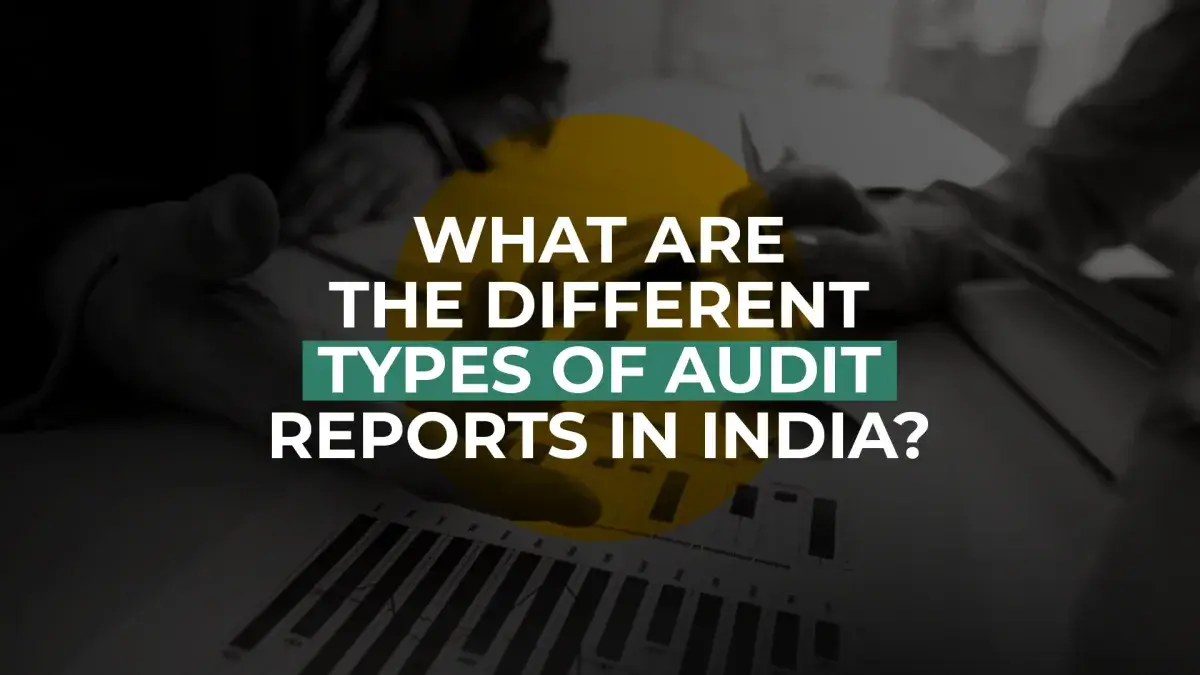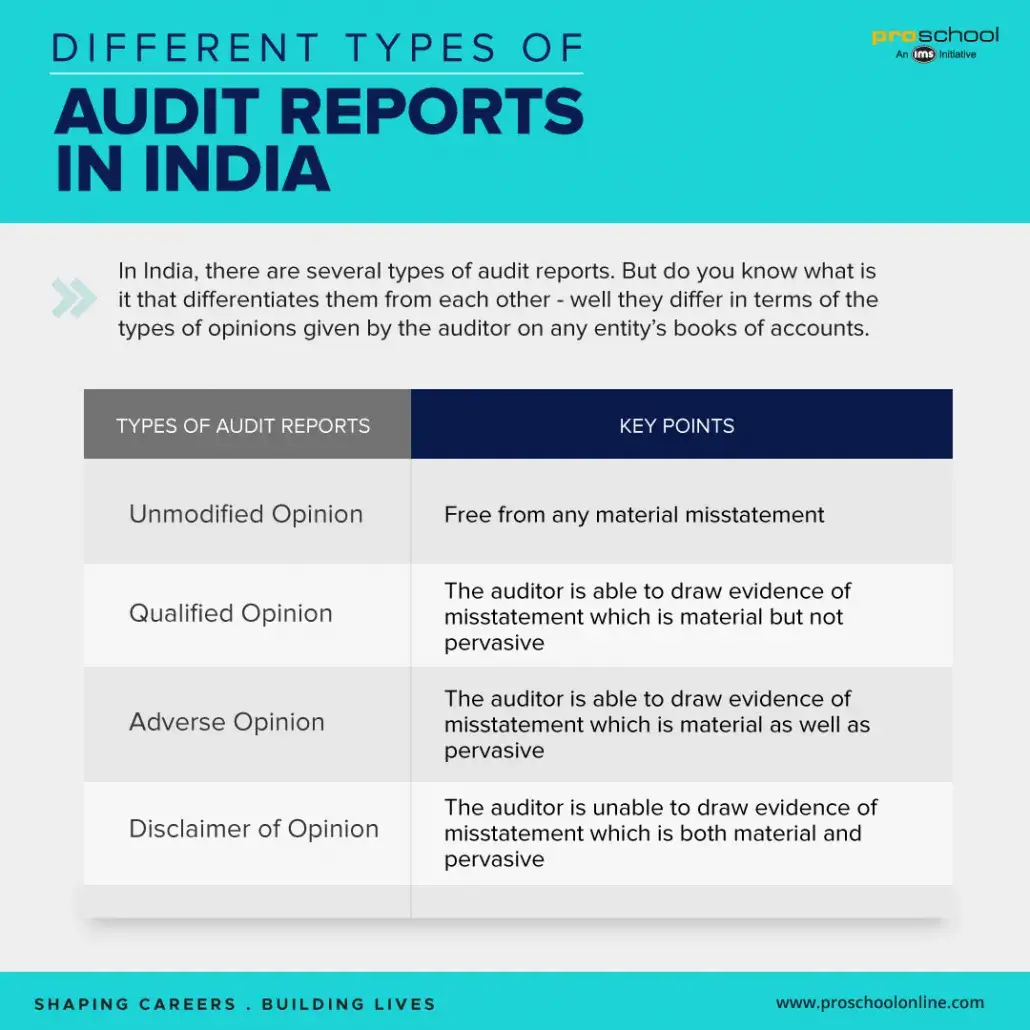What are the different types of audit reports in India?

Here's What We've Covered!
“Two-thirds of the Earth’s surface is covered with water. The other third is covered by auditors from headquarters.” – Norman Ralph Augustine
Yes, auditors are equally important for the corporates as is water for life on earth, which brings us to the importance of their audit reports. So, there are different types of audit reports, but today we will discuss it in the Indian accounting parlance. In India, the types of audit reports are governed by SA 700 (Revised) that states that “Forming an Audit Opinion & Reporting on Financial Statements” and SA 705 that states that “Modifications to the Opinion in the Independent Auditor’s Report”. SA700 requires an auditor to express his/ her opinion on whether the financial statements are prepared in accordance with applicable fair presentation framework.
Further, the audit reports or opinions revolve around materiality and pervasiveness of the misstatement of financial facts. Basically, materiality deals with the intensity of the misstatement or what are it’s effects on the outcome, while pervasiveness is the spread or extent of the misstatement or it indicates how many of the financial statements have been impacted due to the misstatement. Now that we have a fair bit of idea regarding materiality and pervasiveness of misstatement, we can discuss the different types of audit reports and how they are identified based on materiality and pervasiveness in more details in the next section.
TYPES OF AUDIT REPORTS/OPINIONS
Now, let us move on to the types of Audit Opinions: –
- Unmodified/ Unqualified/ Clean Opinion
- Modified Opinion
- Qualified / Modified Opinion
- Adverse Opinion
- Disclaimer of Opinion
1. Unmodified Opinion – In this case, based on the evidence obtained the auditor expresses an unmodified/ unqualified opinion that the financial statements have been prepared in accordance with the applicable fair presentation framework, which indicates that the financial statements are free from material misstatements.
2. Modified Opinion – In this case, the auditor expresses a modified opinion in the following ways:-
(a) Qualified / Modified Opinion – Here the auditor is either unable to obtain any evidence of misstatement or obtains evidence that the financial statements are misstated but the same is not pervasive. Now, let us look at an illustration to understand the concept.
Illustration 1: Let us assume a case where the inventories have been misstated due to non-application of appropriate accounting principle. Based on the audit evidence obtained, the auditor may conclude that there is no material uncertainty regarding the entity’s ability to continue as a going concern. Thus, the misstatement is deemed to be material but not pervasive. Hence, the audit opinion is qualified as a misstatement.
(b) Adverse Opinion – It is known as adverse opinion when the auditor obtains evidence that misstatement is material as well as pervasive. Now, let us look at some of the illustrations to understand the concept.
Illustration 1: Let us now consider a case where the company has not consolidated the financial statements of a subsidiary it had acquired last year. It came to notice that had the subsidiary been consolidated, many elements of the accompanying financial statements would have been materially affected. However, the effects on the financial statements could not be determined because it is practically not possible to do so. In this case, the misstatement can be considered to be material as well as pervasive.
Illustration 2: In case, a company has filed for bankruptcy and as such, it may be unable to realize its assets and discharge its liability in the normal course of business. In such scenario, the independent auditor can issue an adverse opinion on the true and fair view of the financial statements on account of events that indicate a material uncertainty that cast significant doubt on the company’s ability to continue as a going concern. This event is considered as material and pervasive.
(c) Disclaimer of Opinion – In this case, the auditor is unable to obtain any evidence with respect to a misstatement that is both material and pervasive due to limitations imposed by the management, or natural calamities or extraordinary circumstances. Now, let us look at some of the illustrations to understand the concept.
Illustration 1: Let us look into a case where the auditor was unable to obtain sufficient appropriate audit evidence about a single element of the financial statements because it was not allowed access to relevant source of information. The element represented the company’s investment in a joint venture valued at Rs.90 crores in the company’s Balance Sheet, which represents 90% of the company’s closing net assets as on 31st March 20XX. The probable effects of this inability to obtain sufficient appropriate audit evidence are deemed to be both material and pervasive to the financial statement. Hence, a disclaimer of opinion can be given in such circumstances.
Illustration 2: Let us look into a case where the auditor was unable to obtain sufficient appropriate audit evidence about multiple elements of the financial statements. In fact, the auditor was also unable to obtain audit evidence about the entity’s inventories and accounts receivable. The probable effects of this inability to obtain sufficient appropriate audit evidence are deemed to be both material and pervasive to the financial statement. Hence, a disclaimer of opinion can be given in this case.
STANDARD FORMAT FOR AUDIT REPORTS
Now, let us have a look at the standard format for an auditor’s report that is prescribed by the law & regulation and should be included at the minimum:
- A title
- An addressee
- A section comprising the opinion on the financial statement and reference to the financial reporting framework that has been used in its preparation and mention about management’s responsibility to prepare the financial statements
- Identification of financial statements of the audited entity
- A statement on the auditor’s independence in line with the relevant ethical requirements of an audit
- A section that addresses the reporting requirements of the relevant standard on auditing (if applicable)
- A section for the basis of Qualified (or Adverse) Opinion that addresses the reporting requirements of the relevant standard on auditing (if applicable)
- A section that states the management’s responsibilities in the preparation of the financial statement
- A section that states the auditor’s responsibilities in the preparation of the financial statement
- Signature of the auditor
- Reporting date
CONCLUSION
So, there are different types of audit reports based on the type of audit findings and subsequent opinions expressed by the auditors. Consequently, I hope the article has provided you the information required to build a clear understanding about audit reports and the next time you come across any audit report you will know what it is trying to say.
Read more: AUDITING IN INDIA: ROLE OF AUDITORS IN CORPORATE GOVERNANCE
Resent Post
>
Emerging commerce career options in India (2026): From CA to Data Analyst
>
ACCA Opportunities You Didn’t Know About – Think Beyond Audit!
>
Which Courses After 12th Commerce With High Salary Are in Demand Worldwide?
>
How to Find ACCA Jobs Online After Qualifying: Real Portals, Tips & Career Guidance
>
Financial Modelling Classes in Hyderabad: Your Guide to the Best Institutes
Follow Us For All Updates!




